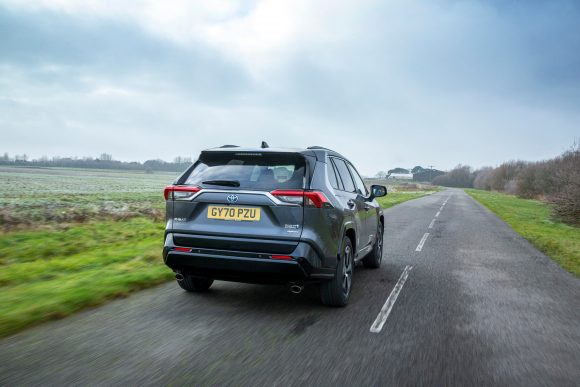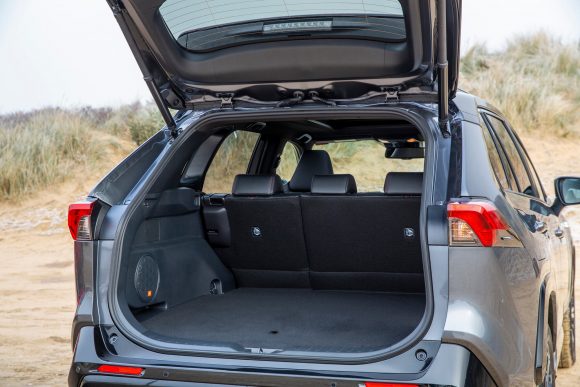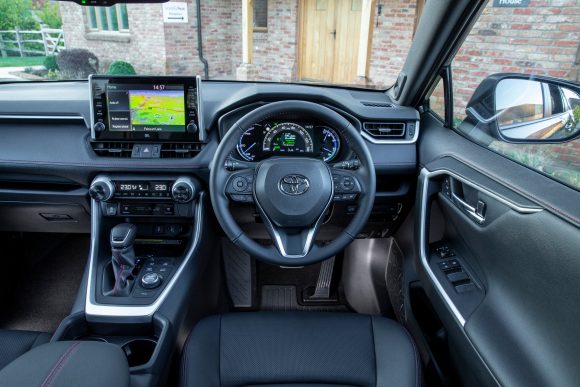Toyota has expanded the RAV4 family with a PHEV model and Jack Evans took to the road to check out the new SUV on the electrified block
What is it?
Toyota has committed itself to an electrified future for quite a while.
Just take a look at its current line-up and apart from a few notables such as the petrol-powered GR Yaris and Aygo, its range is almost completely battery-assisted.
Toyota has a long history of electrification, having broken the mould with its Prius many years ago.
The vast majority of the vehicles in its range use so-called ‘self-charging’ hybrid technology, though, meaning they can’t be topped up via a plug.
Toyota’s popular RAV4 already has one such powertrain, but the manufacturer has now upped the ante by introducing a plug-in hybrid variant that boasts a long electric range and even lower emissions.
What’s new?
The RAV4 PHEV starts at £47,395 which is quite a lot. That’s just over £8,500 more than the equivalent Mitsubishi Outlander and much more than many conventionally driven SUVs.
But while the RAV4 PHEV’s high list price might put it beyond many private buyers, it’s actually been designed with business users in mind.
The CO2 emissions of 22g/km mean a benefit-in-kind rate from six per cent, so a first-year BIK for a 40 per cent taxpayer will be £1,136 – less than the £1,765 an equivalent business user will have to pay for the Outlander.

What’s under the bonnet?
The PHEV we’re driving here uses the same basic layout as the standard hybrid RAV4, but with several important tweaks.
The ability to plug it in to charge is one of the main ones – a full charge will take around two and a half hours via a home wallbox – but there are other changes.
Although the rear motor is still the same, the front motor increases from 88kW in the standard hybrid to 134kW here, while the battery capacity swells considerably from 18.1kWh from 1.1kWh.
The 2.5-litre four-cylinder petrol is left unchanged, but the total power output stands at a considerable 302bhp – an 83bhp gain on the standard hybrid.
Cleverly, though, when the batteries are completely drained, the RAV4 reverts to being a ‘regular’ hybrid – gaining small amounts of assistance from the motors with the last remaining energy – rather than just relying on the engine.
Toyota says you should get up to 46 miles in fully electric mode as well as up to 282.4 mpg with the batteries fully topped up.
What’s it like to drive?
That headline power figure means it’s little wonder the RAV4 PHEV feels so brisk from behind the wheel.
Of course, with its heavy batteries, the performance isn’t supremely urgent, but the claimed 0-60mph figure of just under six seconds feels on the money and more than adequate for a car of this type.
The various modes let you take control of how the battery power is used, but we found that when left to its own devices the automatic setting intelligently deployed the electric power at the right time.
The ride is a touch brittle at slower speeds but composes itself at higher ones.
There’s also an impressive amount of body control, while the silent running of the electric mode ensures that the RAV4 PHEV moves around town in comfortable silence.
Once we ran out of charge we were still seeing around 70mpg – an added benefit of the car’s ability to revert to a traditional hybrid once the battery charge had gone.
How does it look?
The RAV4 was already one of the most eye-catching SUVs on sale so Toyota has, understandably, kept that all largely the same for the PHEV version.
There are a few notable differences, though, such as the dark mesh grille and metallic mouldings for the front bumper.
At the back, the metallic finish continues, while the 19-inch alloy wheels feature a design unique to the plug-in hybrid variant.

What’s it like inside?
There’s a pleasing focus on practicality with the RAV4 and it’s good to see that this hasn’t been lost on the plug-in hybrid model.
For example, the rear seats are spacious and offer up plenty of head and legroom.
Meanwhile, the 520-litre boot is wide and easy to access courtesy of the smallest of boot lips.
There’s also a storage area under the boot floor for the charging cables, so they don’t have to eat into your total load area.
Up front the cabin is bright and spacious, with the seats providing plenty of support.
The view out of the front isn’t impeded too much by the pillars, either, meaning visibility stays good.
There are some harsher plastics used in certain areas of the cabin, but this is a largely well-made place to be.

What’s the spec like?
Given its high starting price, it’s a relief to see that it comes with plenty of standard equipment.
As well as the 19-inch alloys, there’s dual-zone climate control with a remote function and a power boot, as well as Toyota’s Safety Sense 2 system, with adaptive cruise control, rear cross-traffic alert and a pre-collision setup – among other features.
‘Our’ range-topping Dynamic Premium car – costing £50,895 – added black leather seats and a panoramic roof, as well as a premium sound system.
A nine-inch touchscreen system is standard on both and while it features all the main functions that you’d want, it falls behind rival systems in terms of design and ease of use.
What do we think?
For private owners, the RAV4 plug-in hybrid makes little sense. It’s simply too expensive compared with rival SUVs, despite its good amount of standard equipment.
For these drivers, it’s likely that the regular – and still very accomplished – RAV4 will be more than adequate.
But when it comes to business drivers and fleet operators, this plug-in hybrid’s low emissions and decent electric range will prove very attractive indeed.
The fact that the RAV4 is good to drive and practical will only prove to be the icing on the cake for these buyers.
The knowledge
Model: Toyota RAV4 PHEV
Base price: £47,395
Model as tested: RAV4 Hybrid PHEV Dynamic Premium
Price: £50,895
Engine: 2.5-litre four-cylinder petrol linked to dual electric motors
Power: 302bhp
Max speed: 112mph
0-60mph: 5.7 seconds
MPG: 282.4
Emissions: 22g/km CO2


































